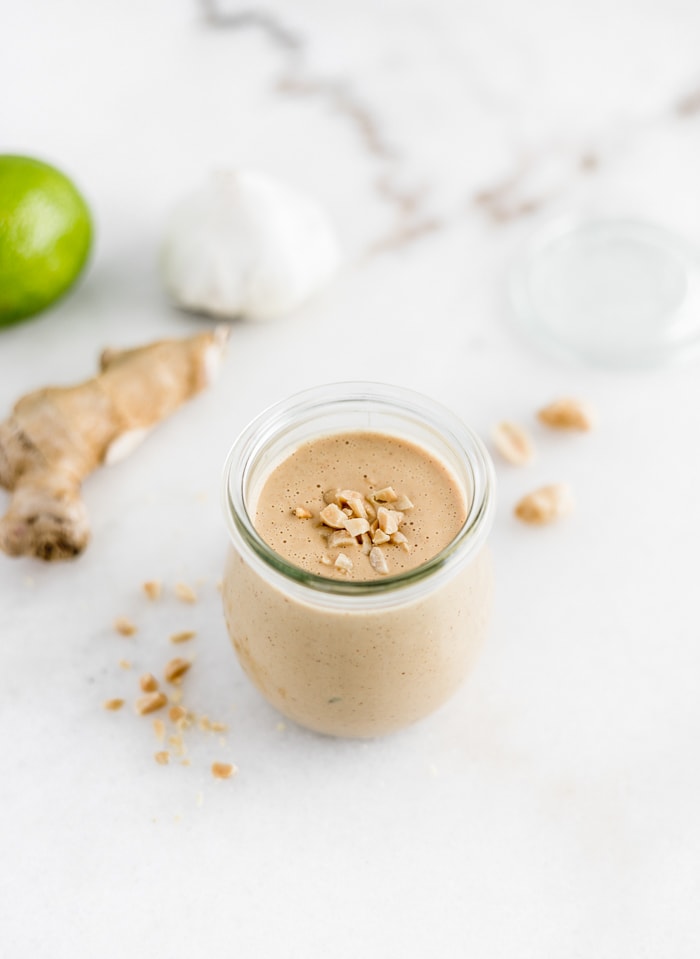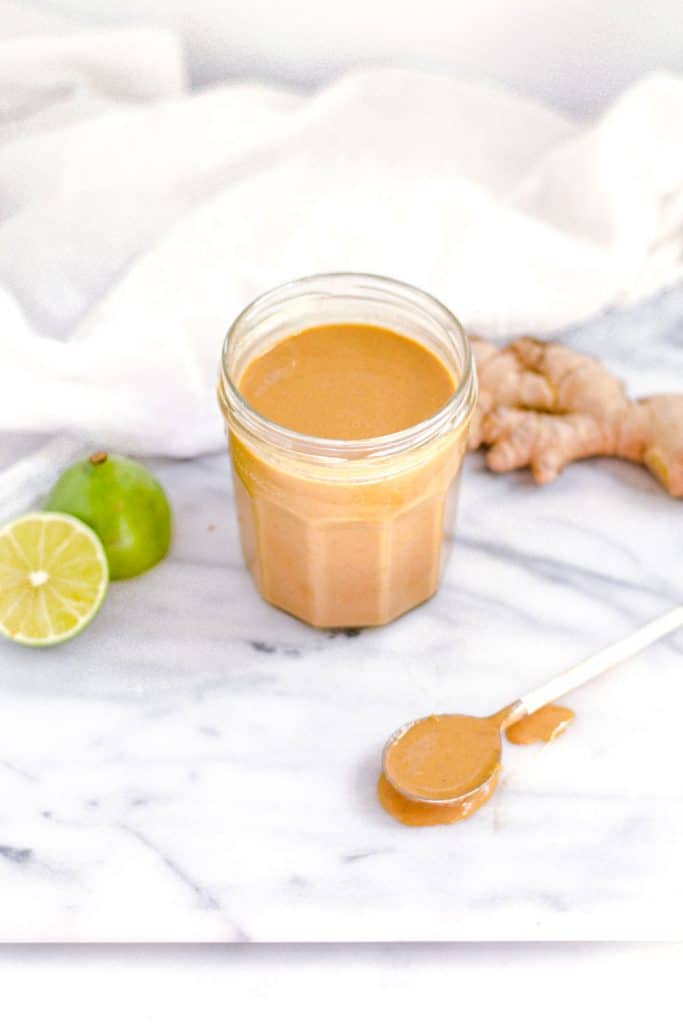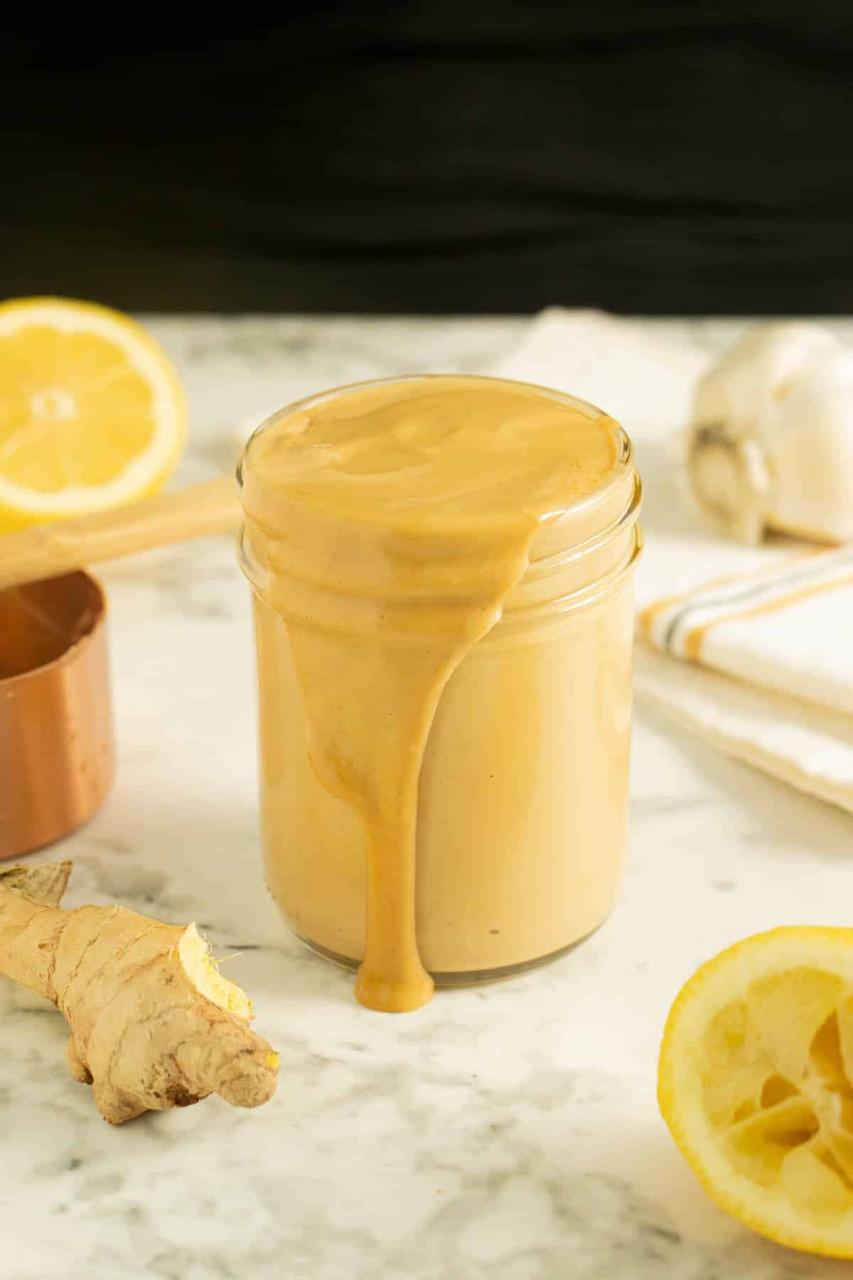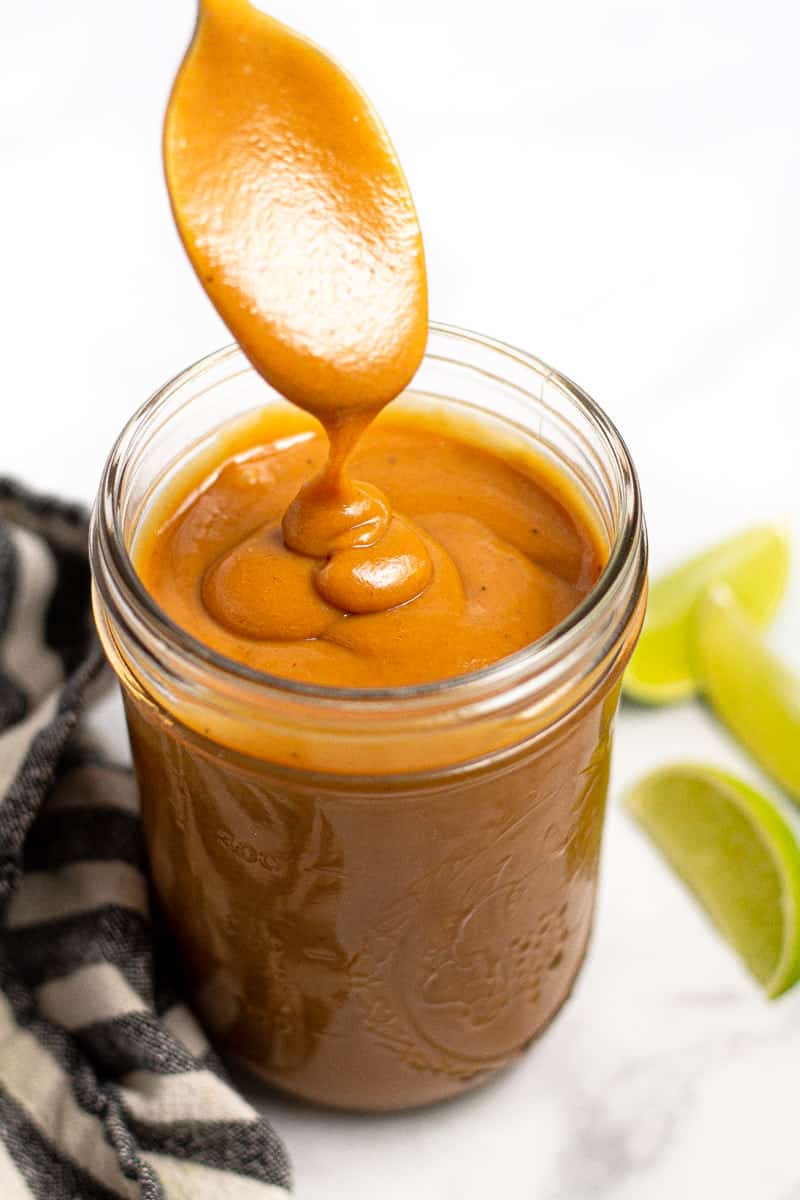Ginger Peanut Sauce is an alluring twist on the classic peanut sauce, integrating the warm and spicy essence of ginger. This aromatic root lends its distinctively fiery and slightly sweet flavor to the traditional base of ground roasted peanuts or peanut butter. The result is a sauce that not only possesses the creamy, nutty characteristics of its counterpart but is also elevated by the zesty and pungent notes ginger brings to the table.
Like basic peanut sauce, this variation likely includes usual accompaniments such as garlic, soy sauce, maybe coconut milk, and a touch of sweeteners like brown sugar or honey to round out the flavors. It may also feature lime juice or vinegar to provide a counterbalance to the sweetness, introducing a layer of freshness that complements the robustness of ginger.
This fusion not only enhances the sauce’s complexity but also boosts its versatility in the culinary realm. Ginger Peanut Sauce can be used in similar applications as the traditional version: as a dipping companion for dishes like satay or spring rolls, drizzled over salads or noodle bowls, and as a vibrant addition to stir-fries or wraps. Moreover, it may serve exceptionally well with dishes that benefit from a ginger-forward profile, such as certain Asian-inspired chicken or tofu preparations.
Making Ginger Peanut Sauce typically involves combining finely grated or minced fresh ginger with peanut butter and other ingredients until a smooth and homogenous mixture is achieved. Its consistency can be adjusted for different uses by adding water or coconut milk, creating either a thick dip-worthy texture or a more pourable dressing-like consistency.
Ginger Peanut Sauce Recipe


Ginger Peanut Sauce
Equipment
- 1 medium mixing bowl
- 1 air tight container
Ingredients
- 1/2 cup salted natural peanut or almond butter
- 2-3 tbsp brown sugar or maple syrup add to taste
- 1/2 medium lime juiced
- 1 1/2 tbsp soy sauce tamari for gluten-free eaters
- 1/2 tsp chili garlic sauce
- 1/2 tsp fresh grated ginger optional
- Hot water (to thin
Instructions
- Combine all the ingredients in a medium mixing bowl except water and whisk well until mixed. The sauce should be pourable. Set aside.
- Add warm water to thin (little at a time) and whisk as you add until smooth and creamy pourable sauce is achieved.
- Taste and make adjustment as needed.
- Serve immediately as you want or store in an air tight container and keep in the fridge, use within 2 weeks.
Cooking Tips about Ginger Peanut Sauce

- Fresh Ginger: Use fresh ginger root for the best flavor. It should be peeled and finely grated or minced to ensure even distribution throughout the sauce. The freshness of ginger will provide a vibrant and punchy taste compared to powdered ginger.
- Quality Peanut Butter: For a rich and authentic taste, opt for a natural, unsweetened peanut butter. The quality of the peanut butter will greatly affect the final taste of the sauce.
- Balance the Flavors: The harmony between sweet, sour, salty, and spicy flavors is crucial in Ginger Peanut Sauce. Start by adding smaller amounts of each flavoring ingredient—such as soy sauce, lime juice, brown sugar or honey, and chili—and adjust according to your taste preferences.
- Adjustable Consistency: Depending on how you wish to use the sauce, you can adjust its consistency. For a thicker dip, add less liquid; for a salad dressing or marinade, thin the sauce out with a little bit of water or coconut milk.
- Slow Simmer: If you have time, let the sauce simmer on low heat for a few minutes after combining all the ingredients. This heating process can help meld the flavors together more cohesively and bring out the richness of the peanut butter and the brightness of the ginger.
- Taste as You Go: Continuously taste your sauce as you mix in each ingredient. This will help you find the perfect balance for your palate.
- Add Heat if Desired: If you enjoy a little kick, incorporate chili flakes, chili paste, or fresh chili peppers. Be sure to add gradually and taste so you don’t overwhelm the gingery notes.
- Lime Juice for Tanginess: A squeeze of fresh lime can add a refreshing element that complements the ginger perfectly. Bottled lime juice can work in a pinch, but fresh lime juice is preferred for its zesty flavor.
- Sweeteners are Key: Sweeteners like honey, brown sugar, or agave syrup can help tame the heat of the ginger and chili. They also bring out the nutty flavors of the peanut butter.
- Garnishing Touches: Before serving, consider garnishing the sauce with chopped fresh cilantro or scallions for a pop of color and additional flavor.
Serving suggestions about Ginger Peanut Sauce

- Dipping Sauce: Use Ginger Peanut Sauce as a dip for appetizers like chicken satay, spring rolls, or fresh summer rolls. Its zesty kick will add an extra layer of flavor.
- Noodle Dressing: Toss it with warm noodles, such as soba or rice noodles, along with julienned vegetables for a quick and satisfying meal. The sauce’s warmth from the ginger makes it perfect for these dishes.
- Salad Dressing: Drizzle Ginger Peanut Sauce over Asian-inspired salads. It works especially well with salads containing crunchy cabbage, carrots, and bell peppers, adding richness and depth.
- Stir-fry Enhancer: Elevate a vegetable stir-fry by adding a spoonful of Ginger Peanut Sauce in the last minutes of cooking. It’ll coat the ingredients nicely, providing a bold flavor that complements the freshness of the veggies.
- Marinade for Proteins: Marinate tofu, chicken, or beef in Ginger Peanut Sauce before grilling or baking. The ingredients will absorb the ginger’s heat and the peanuts’ savory notes.
- Wrap or Sandwich Spread: Spread Ginger Peanut Sauce onto tortilla wraps or bread when assembling sandwiches. It pairs beautifully with fillings like sliced cucumbers, grilled chicken, or tofu.
- Bowl Topper: A generous dollop of Ginger Peanut Sauce can be the finishing touch on a Buddha bowl. Sprinkle on some sesame seeds and fresh herbs to complete the dish.
- With Grilled Vegetables: Brush Ginger Peanut Sauce onto corn on the cob, zucchini, or bell peppers while grilling for an exciting twist on your barbecue lineup.
- Rice Dish Flavoring: Stir Ginger Peanut Sauce into warm rice dishes or over steamed jasmine rice for an instant flavor booster that’s both comforting and gourmet.
Top 5 FAQs about Ginger Peanut Sauce

- What is Ginger Peanut Sauce? Ginger Peanut Sauce is a savory and zesty variation of traditional peanut sauce that incorporates the warm, spicy flavor of fresh ginger with the creamy, nutty taste of peanut butter. It often includes ingredients like garlic, soy sauce, coconut milk, and sweeteners such as brown sugar or honey, with lime juice or vinegar adding tanginess.
- How do you make Ginger Peanut Sauce? To make Ginger Peanut Sauce, finely grate or mince fresh ginger and blend it with peanut butter, adding garlic, soy sauce, a sweetener, and possibly coconut milk. Adjust the consistency with water or additional coconut milk as desired and bring together over low heat if you prefer a more cohesive flavor profile.
- Can Ginger Peanut Sauce be used as a marinade? Yes, Ginger Peanut Sauce makes an excellent marinade for meats such as chicken or tofu. The ginger not only tenderizes the meat but also infuses it with its distinctive spicy-sweet flavor.
- How do you adjust the thickness of Ginger Peanut Sauce? For a thicker sauce, add less liquid. If you desire a thinner consistency for dressings or marinades, incorporate more water or coconut milk until it reaches the preferred texture.
- What dishes pair well with Ginger Peanut Sauce? This sauce pairs wonderfully with Asian-inspired dishes such as satay, spring rolls, salads, noodle bowls, and stir-fries. It can enhance the flavor of chicken or tofu recipes and also serves as an innovative dip or spread for wraps and sandwiches.
In conclusion, Ginger Peanut Sauce is an invigorating and flavorful rendition of the classic peanut sauce, marked by its incorporation of fresh ginger, which imparts a distinct and lively spiciness. This zesty root deepens the complexity of flavors, joining the creamy, satisfying base of peanut butter to create a harmonious fusion with a notable gingery twist.
Its versatility shines through in its various culinary applications: whether it’s being used as a dipping sauce for appetizers, a robust dressing for noodle dishes and salads, a vibrant stir-fry addition, or even as a marinade to infuse proteins with its characteristic zing. The inclusion of customizable ingredients like garlic, soy sauce, sweetening agents, and lime juice offers home cooks the freedom to tailor the sauce to their taste preferences, adjusting sweetness, tanginess, and spice levels.
Moreover, the benefits of ginger add a potential health-promoting angle to the sauce, making it not just a treat for the taste buds but also a mindful choice for those looking to add a little more zest to their meals in a wholesome way.
Leave a Reply